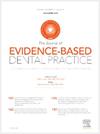EFFECTIVENESS OF ASSISTED TOOTHBRUSHING ON PRESCHOOLERS’ ORAL HYGIENE: A CAREGIVER-INTERVENTION APPROACH
IF 4
4区 医学
Q1 DENTISTRY, ORAL SURGERY & MEDICINE
引用次数: 0
Abstract
Objective
To assess the effectiveness of an intervention on caregivers' assisted toothbrushing techniques and oral health maintenance for preschool-aged children, and to determine whether these effects differ by age.
Methods
A single group pre/post intervention study was conducted among children aged 3-5 years and their caregivers in Callao, Peru. Eligible caregivers were trained on assisted toothbrushing using large and real-scale typodonts, along with practical demonstrations by a dentist. Additionally, they were instructed on healthy practices and oral health in children. Children's oral hygiene status (OHS) was assessed using the Simplified Oral Hygiene Index (OHI-S) at baseline and three months postintervention. To assess the effectiveness and quantify the magnitude of the difference between the OHI-S before and after the intervention, we used Wilcoxon signed-rank test and the Cliff's Delta test, respectively. Results were stratified by age group to examine potential differences.
Results
The sample (n = 210) predominantly comprised 3-year-old Peruvian females, primarily cared for by their mothers, who identified as single mothers who had not previously received instruction in oral hygiene practices. We found improvement in children's OHI-S in most age groups. Specifically, among 3-year-olds, the OHI-S score improved significantly from 'fair' (m = 2.6, ± 0.2, range 2.4-2.8) to 'good' (m = 1.1, ± 0.2, range 0.9-1.3). The intervention showed a moderate effect size (δ = −0.15, 95% CI −0.18, −0.10) in the 3-year-olds and a moderate effect size (δ = −0.05, 95% CI −0.08, −0.01) in the 4-year-olds. No significant improvements were observed in the 5-year-old group.
Conclusion
A caregiver-focused intervention significantly improved OHS among preschool-aged children, particularly in younger age groups. Substantial improvements in OHI-S scores were noted for 3- and 4-year-olds, while age-specific factors may have limited efficacy in the 5-year-old group. These findings highlight the importance of early, targeted oral health education for caregivers.
辅助刷牙对学龄前儿童口腔卫生的影响:一种照顾者干预方法
方法 在秘鲁卡亚俄对 3-5 岁儿童及其看护者进行了单组干预前后研究。符合条件的看护人接受了使用大型真实牙托辅助刷牙的培训,并由牙医进行了实际演示。此外,他们还接受了有关儿童健康做法和口腔健康的指导。在基线和干预后三个月,使用简化口腔卫生指数(OHI-S)对儿童的口腔卫生状况(OHS)进行评估。为了评估干预前后OHI-S的有效性和量化差异的大小,我们分别使用了Wilcoxon符号秩检验和Cliff's Delta检验。结果样本(n = 210)主要由 3 岁的秘鲁女性组成,主要由母亲照顾,她们都是单身母亲,以前没有接受过口腔卫生指导。我们发现,在大多数年龄组中,儿童的口腔卫生知识水平都有所提高。特别是在 3 岁儿童中,OHI-S 分数从 "一般"(m = 2.6,± 0.2,范围 2.4-2.8)显著提高到 "良好"(m = 1.1,± 0.2,范围 0.9-1.3)。干预对 3 岁儿童的影响程度为中等(δ = -0.15,95% CI -0.18,-0.10),对 4 岁儿童的影响程度为中等(δ = -0.05,95% CI -0.08,-0.01)。结论 以照顾者为中心的干预能明显改善学龄前儿童的户外活动能力,尤其是在较小的年龄组。3岁和4岁儿童的OHI-S得分有了大幅提高,而5岁儿童的年龄特异性因素可能限制了干预的效果。这些研究结果突显了对照顾者进行早期、有针对性的口腔健康教育的重要性。
本文章由计算机程序翻译,如有差异,请以英文原文为准。
求助全文
约1分钟内获得全文
求助全文
来源期刊

Journal of Evidence-Based Dental Practice
DENTISTRY, ORAL SURGERY & MEDICINE-
CiteScore
6.00
自引率
16.70%
发文量
105
审稿时长
28 days
期刊介绍:
The Journal of Evidence-Based Dental Practice presents timely original articles, as well as reviews of articles on the results and outcomes of clinical procedures and treatment. The Journal advocates the use or rejection of a procedure based on solid, clinical evidence found in literature. The Journal''s dynamic operating principles are explicitness in process and objectives, publication of the highest-quality reviews and original articles, and an emphasis on objectivity.
 求助内容:
求助内容: 应助结果提醒方式:
应助结果提醒方式:


